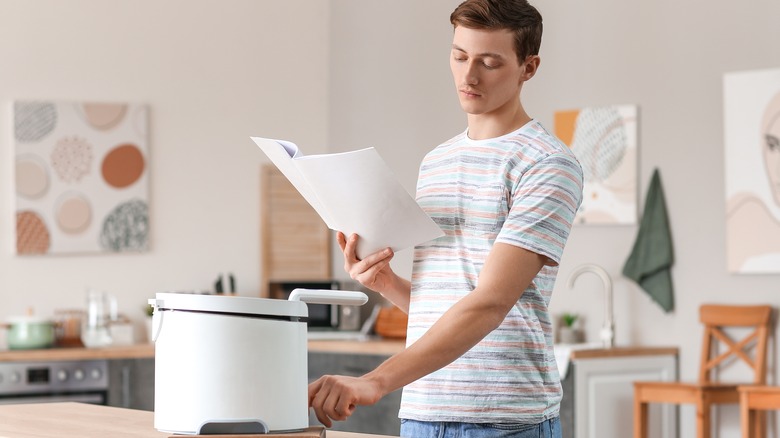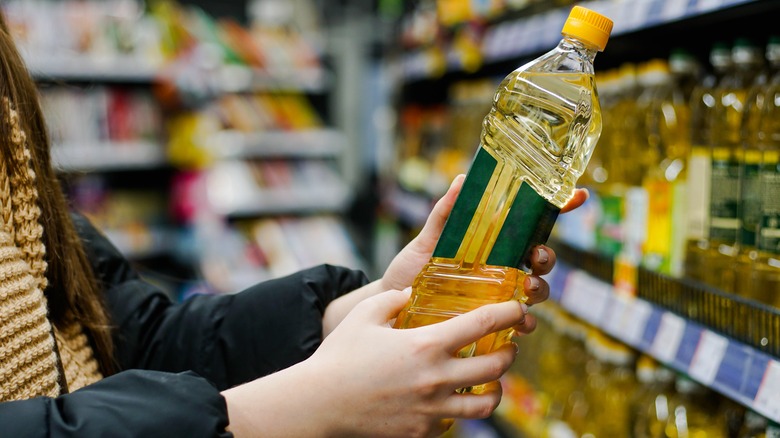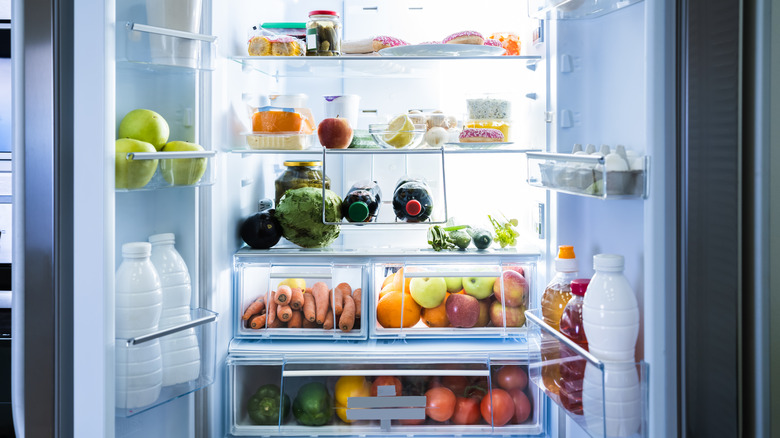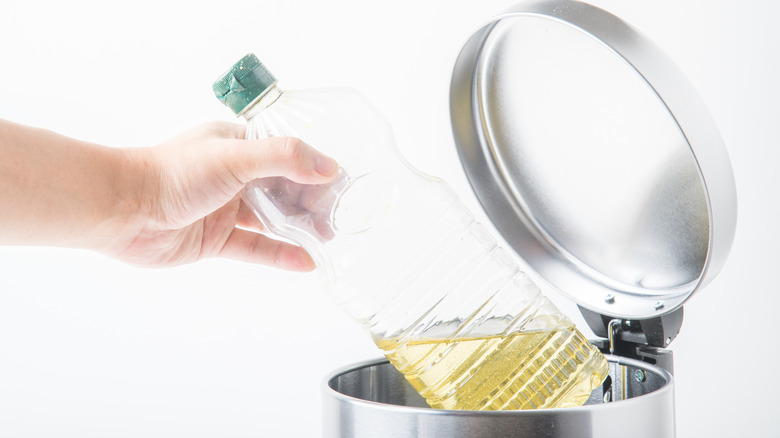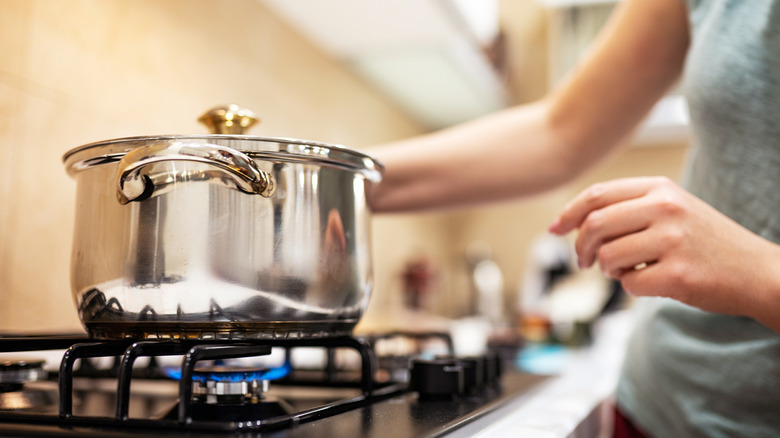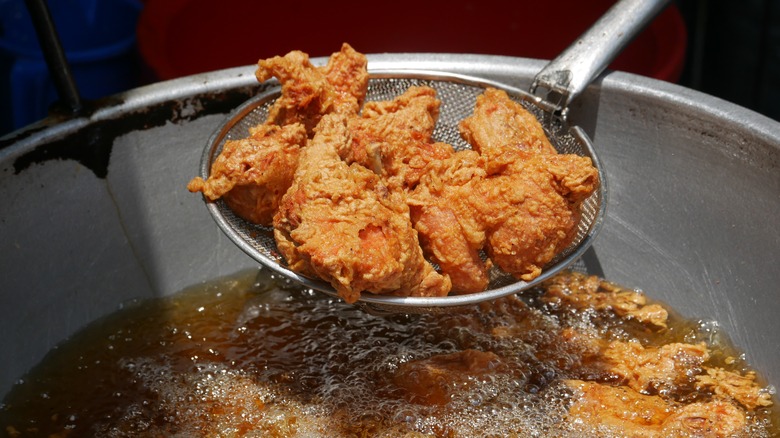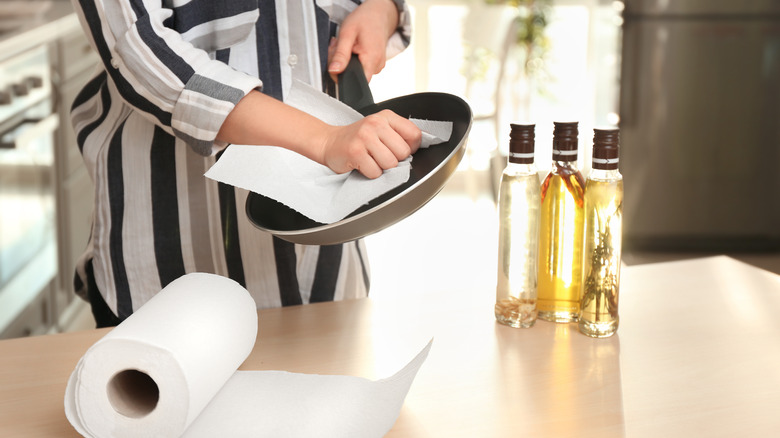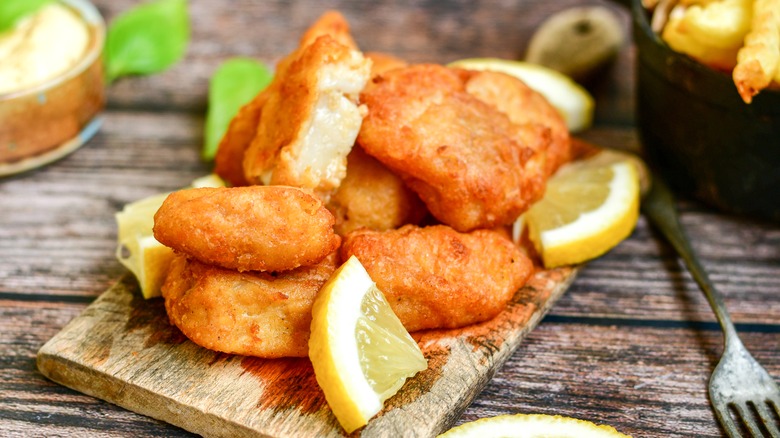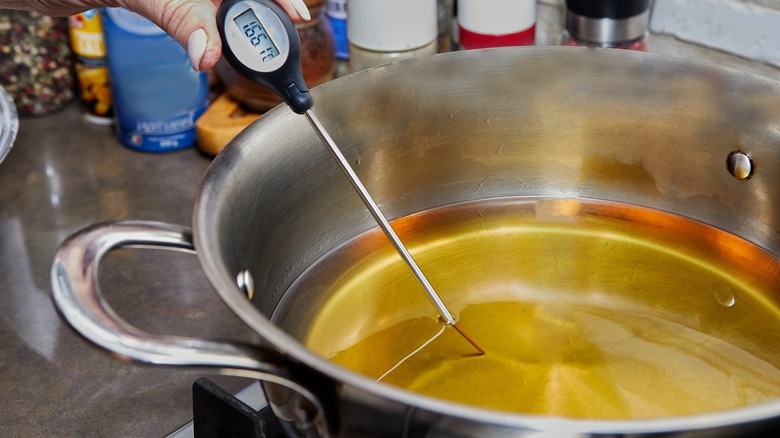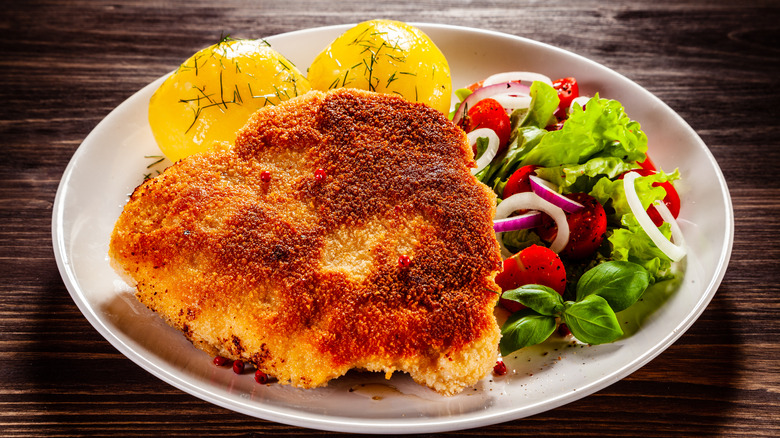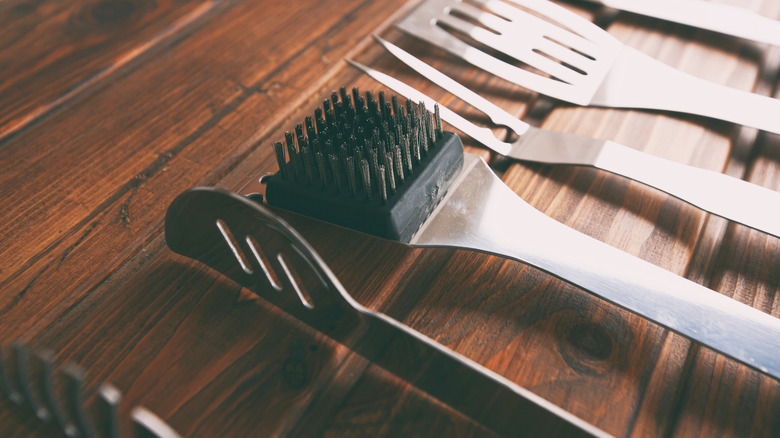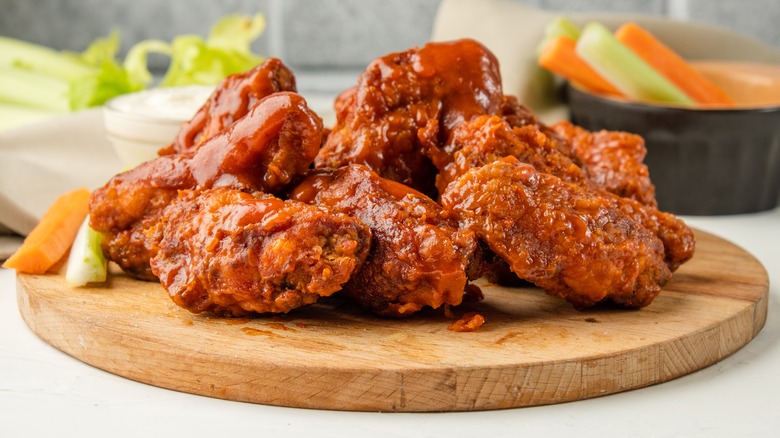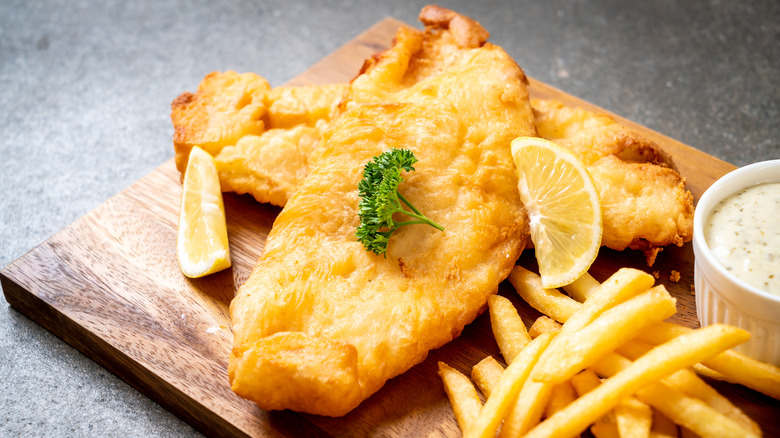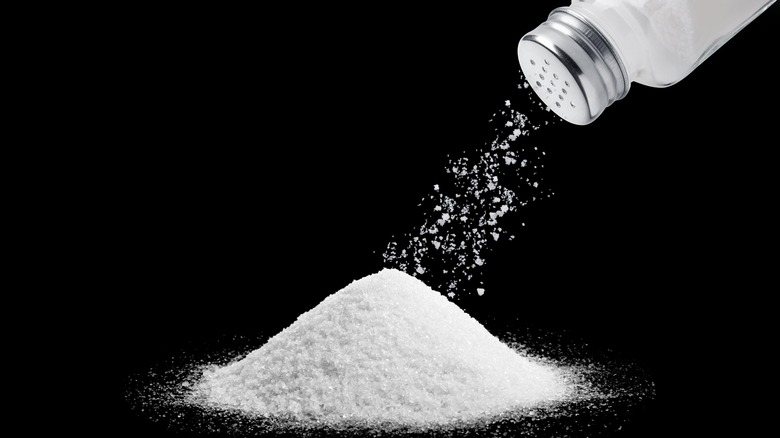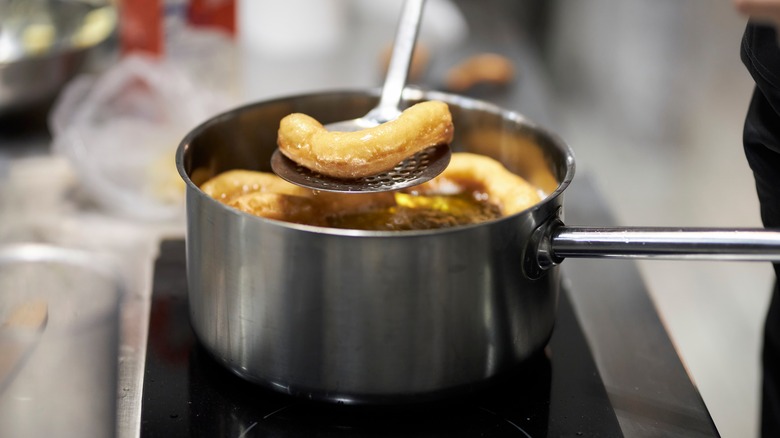15 Mistakes You Need To Avoid When Deep Frying
There's nothing quite like deep-fried food. The addictive crunch as you bite into a well-fried piece of chicken or a mozzarella stick ... We can't lie, we're big fans. But deep frying food has more going for it than just the crunch it provides. This method of cooking is a speedy way to whip up a meal and helps to lock flavor and quality into your food, states Frymax. And while deep frying is commonly associated with certain foods, the cooking style can be used to prepare a surprisingly large amount of things, from Brussels sprouts to falafel (per Mashed).
But, while deep frying can seem easy, it can go wrong fast. And anything that involves working with piping hot oil takes a little technique. Whether it's down to the temperature of your oil, the type of oil you choose, or how you prepare your food, one false move can result in a less-than-satisfying dish. And that's where we step in, folks. Let's take a look at all the mistakes you need to avoid when deep frying, and what to do instead.
Using the wrong oil
You'd be correct in assuming that all cooking oils perform essentially the same function: They help cook your food, right? Well, yes, but how they do it can vary significantly, and not all of them are suited to deep frying. All oils have a "smoke point," which is the temperature when –- you guessed it! –- they start to smoke, says Mashed. When you're deep frying, you're operating at high temperatures, and as such, you need a high smoke point to avoid filling your kitchen with fumes and potentially causing a hazard.
So which oils are the best to deep fry with, and which are the worst? It's hard to go wrong with all-purpose vegetable oil, Tefal explains. Vegetable oil operates well at high temperatures, and its neutral taste will ensure that it doesn't imbue your food with any flavor undertones you'd rather not add to your meal.
Sunflower and rapeseed oil are also two great options, as they remain stable when you crank up the heat. It's best to avoid putting extra virgin olive oil or coconut oil into your fryer, though, as both of these have a low smoke point, and so may create problems when you warm them up.
Frying certain items straight out of the fridge
One of the major benefits of using a deep fryer is how quick they are, but adding a little extra time to your cooking process to bring your food to room temperature is advised. Keeping food in the fridge right up until the moment you cook it can produce an uneven result, with your food items cooked on the outside but still colder, or even raw, on the inside (per Bon Appetit). Dropping cold food into hot oil will also bring the oil's temperature down, meaning things take longer to cook overall.
So, give yourself some additional time before you start the cooking process, take your food out of the refrigerator, and wait. If you're making fried chicken, half an hour left at room temperature should be sufficient to wait before you bread and cook it, to make sure you get crispy skin and perfectly-cooked meat.
The exception is, of course, food that you deep fry straight from the freezer. Make sure that you're reading the manufacturer's cooking instructions on the back of the package for freezer food before you start deep frying.
Throwing away your deep fry oil after one use
It might seem natural to get rid of the oil in a deep fryer once you're done. After all, you clean your pans after using them when you shallow fry, so surely it's the same when you're deep frying, right? Well, not quite. Depending on what you're cooking, you can use deep frying oil multiple times before changing it (per The Daily Meal).
If you're frying items that won't result in bits of batter or breading flaking off, you're safe to reuse your fry oil half a dozen times or so before it needs replacing. You might get slightly less use out of oil used to cook breaded items. In addition to detritus floating around in your oil, a good way to know that it needs changing is if it's darkened significantly, or starts to smell a little nasty. Make sure that you don't just leave your oil in the deep fryer until you next use it, though. Pour it out, running it through a cheesecloth into a clean bottle, and store it in your fridge until the next time you need it.
Deep frying with the wrong type of pan
At its simplest level, all you need to deep fry food is a container, heat, and a lot of oil. But the container you choose can make a big impact on your final product. The main thing you need is a good amount of depth. When your pan is too shallow, your food won't be fully covered by the oil, resulting in uneven cooking and potential splattering that could be dangerous (per World of Pans). Your pan also needs to be of a certain width, so that everything fits well.
While you can use nonstick pans to deep fry food, it may be worth seeking out something a little more heavy-duty, as frequent use of nonstick materials at high heat can deteriorate the coating, which means that your pan won't last as long. So what's the best utensil for deep frying? Well, if you don't have access to a deep frying machine, a dutch oven is your next best bet. The high walls and sturdy nature of a dutch oven mean that they're capable of containing a good volume of food and oil, without things splattering all over your kitchen, says Tasting Table.
Underheating your oil
There are few things worse than undercooked food. And when it comes to deep frying, ensuring a perfectly cooked bite begins with making sure that your oil is hot enough. Although attempting to cook at lower temperatures may seem logical to avoid oil splatter, health hazards, and burnt food, the fact of the matter is that when your temperature is too low, not only does the food not cook properly, but it absorbs the oil, says Tasting Table. When that happens, your food doesn't become crispy and well-fried, but greasy and heavy.
The solution to this, as you might expect, is to make sure your oil is hot enough before frying. But what if you don't have a cooking thermometer? Luckily, there are a few easy ways to check whether your oil is ready. The "spoon method" is arguably the easiest, where you take the handle of a wooden spoon and place it in the oil, says Delishably. If no bubbles appear, you need to heat your oil some more. If the oil starts bubbling wildly, on the other hand, it's too hot, and you need to lower the heat. The ideal scenario is if the oil bubbles consistently –- then you know that you're good to go.
Not cleaning your deep fryer
Deep frying machines are built to withstand high heat and tough conditions, but that doesn't mean that they don't need maintenance. And cleaning your deep fryer regularly will help you to maintain its lifespan and avoid it breaking or malfunctioning, as well as absorbing flavors that then make your food taste rotten (per Mr. Appliance).
Cleaning a deep fryer, though, is luckily pretty simple. Make sure that it's cool and unplugged, and then remove the frying oil, saving it if possible to reuse — one nifty trick is to use gelatin to clean your deep fry oil, as Mashed explains. Then, take out the wire basket, and wash or soak it in warm water, with soap or vinegar added to it. While the basket is soaking, take a soft-bristled brush and use it to remove any food debris inside the machine, wiping it with paper towels afterward.
For a thorough clean, you can then fill the deep fryer with water and bring it to a boil, before removing once cool, wiping with a soapy cloth, rinsing, and allowing it to dry fully, before reassembling. And that's it! Your deep fryer is good to go.
Trying to fry too much at once
If you're planning on cooking a big meal for friends, but you're short on time, it might be tempting to just throw everything you have into the fryer in one go and hope for the best. After all, as long as the oil is covering the food, what's the worst that can happen?
Well, unfortunately, doing so can ruin your meal. If you overcrowd your deep fryer, the temperature of the oil will drop to a point that it's no longer cooking your food correctly, as Today explains. This will then leave you with undercooked food, and likely, some pretty disappointed guests. Instead, "Think of it as a bath; you don't want too many people in there," advises ChipShop chef and owner (and frying expert) Chris Sell. If your food doesn't have adequate space to move in the oil, both horizontally and vertically, it's likely that you have too much in there. If that's the case, it's best to fry your food in batches.
Heating your oil too much
It's no secret that deep frying food requires pretty hot oil. But it's all too easy to take this a step too far. And if you heat your oil too much, things can go wrong quickly. Not only can this result in burnt and unappetizing food, but heating the oil excessively may also cause it to billow out smoke, an unpleasant experience for all involved (per Mashed). Oil heated to too high a temperature may also damage the pan or deep frying machine you're using.
To avoid this, ensure that your oil is heated to just the right degree. The ideal temperature for deep frying different foods can vary slightly, but generally, a temperature of between 175-180 degrees Celsius (approximately 345-360 degrees Fahrenheit) should be sufficient for many things, as Frymax states.
Remember, too, that the key to achieving perfect food is in the cooking time. Certain items, like larger pieces of fried chicken, may take up to 15 minutes in the fryer, whereas smaller things like mozzarella sticks or onion rings may only take a couple of minutes to cook fully.
Breading your food incorrectly
One of the true pleasures of deep frying food is the all-over crunch that's provided by breaded items. But one of the key mistakes people make around deep frying is breading things incorrectly, which can lead to your coating falling off mid-fry, and leaving exposed food and bits floating around in your oil.
The solution to this is to make sure your breading technique is on-point. Begin by making sure every item you're frying is as dry as possible, by dabbing them with a paper towel to remove excess moisture, says Livestrong. Then, dunk the food in a mixture of egg and milk, with any salt or seasonings you desire added. You then need to place the wet food into flour or cornstarch, coating it fully, before placing it back into the liquid mixture, until it's wet again.
Finally, place the piece of food in a mixture of seasoned breadcrumbs or flour, making sure that it's completely covered, before allowing it to rest in the fridge for a little while, so that the coating adheres to the food a little more. When you're ready to cook, take the food out, allow it to come up in temperature slightly, and then place it gently in the deep fryer.
Not considering safety precautions
Deep frying food can be fun, but the fact that you're working around very, very hot oil is inescapable. And with that comes a host of safety considerations, which could result in harm pretty quickly. The first thing to consider is how close you get to the oil, which can splatter when the food's cooking. That's why it's vital to get yourself a pair of long tongs so that you can work the food from a good distance, says the Safety Company.
Make sure that your deep fryer lid doesn't remain open during your cooking process, too. Ideally, you want to keep the lid shut while your food's cooking, only opening it when you're putting food in or taking it out, to reduce the risk of being burned by oil. Finally, bear in mind that oil and water don't mix, and hot oil and water definitely don't. Water used on an oil fire can result in a dangerous situation, states the senior director of training & development at ServiceMaster Brands Peter Duncanson via Mashed. Instead, "Have an all-purpose or grease fire extinguisher nearby," in case anything goes wrong, Duncanson says.
Your food is the wrong size
We all want our food to be satisfying, and a large piece of deep-fried food can be some people's idea of heaven. But sometimes, pieces that are too big or mismatched can create problems. This can be a particular issue when you're cooking things that are raw on the inside, like meat, with bigger pieces taking longer to cook through fully, meaning that you may end up with a difference in doneness. If you're cooking different cuts of chicken, for example, your wings may be done well before your thighs.
As such, the best thing to do is to make sure that all of your food is uniform. Cook meat of similar size together, as ThermoPro states. If you're cooking things like chicken breasts or pork chops, ensure that you cut them up so that they're around the same size. Remember, too, that one of the best ways to ensure that your meat is cooked through is to use an internal thermometer. If you're cooking chicken, the deepest part of the meat should read a minimum of 165 degrees Fahrenheit for it to be fully cooked through and any harmful bacteria killed, says ThermoBlog.
You haven't nailed your batter
When enjoying deep-fried food, much of the pleasure of what you're eating comes from the batter surrounding whatever tasty morsel you've just cooked. But just as a good batter can give virtually any food an enviable crunch and texture, a bad batter can quickly make your meal heavy, soggy, and unappetizing.
That's why half of the battle of achieving perfect food in the deep fryer is in the batter you make. Make sure that you use quality flour that's well-sifted before mixing with the wet ingredients, to avoid clumps (per Cookist). Although it can be tempting to put salt in a batter to ensure evenly-spread flavor, doing so can also change the texture of the batter, resulting in a heavier end product. It's far better to add salt after cooking.
Remember, too, that while you can make a batter with a range of wet ingredients, with things like eggs, wine, and beer all adding different aromas, flavors, and textures, you can also keep things simple. For newbies to deep frying, try whipping up a basic batter with sparkling water, flour, and a little baking soda, with a touch of pepper for flavor.
Adding salt before cooking
Salt is an essential ingredient in all types of food, and deep-fried foods are no different. But unlike other recipes where you add salt as you go, when deep frying food you should hold off adding salt until the very end. Why? When you add salt to food, it causes the natural moisture in it to seep out and come to the surface, states Tasting Table. This can not only create a drier dish but can also increase the likelihood that significant amounts of water will come into contact with the hot oil, causing dangerous spitting. Additionally, when you have high levels of salt coming into contact with your oil, the oil can then degrade faster, and you end up having to replace it sooner (per Fry Max).
So, how do you get that salty taste into your food? It's simple –- just add the salt after (per Tasting Table). After removing your deep-fried food from the oil, place it on a paper towel and sprinkle it with salt before it gets cold so that the salt flakes adhere to the food properly. If you're cooking with meat and want some flavor inside, brining your chicken pieces or cuts of pork can help to imbue them with additional salt.
Putting wet food into your deep fryer
For many foods, having an adequate level of moisture is vital. After all, who wants a dry piece of meat, or vegetables that have been sapped of their water? But while deep frying is an excellent way to lock in moisture, you need to be careful about how much water makes contact with your frying oil, as wet food entering piping-hot oil can cause significant amounts of splatter, says BBC Good Food.
The reason for this is all down to science: The water, when it enters the oil, evaporates instantly, and this evaporation under the surface of the oil forces it to the top, explains Fry Max. This can then create an eruption effect, with oil flying out everywhere, creating the risk of burning and scalding.
That's why patting down your food before you fry it is vital. Simply take a few pieces of kitchen towel, and blot the surface of your food to remove any excess moisture. You should also try to place your food into the fryer as far away as possible, particularly if you're cooking something with a batter that has the potential to cause splatter, Fry Max says.
